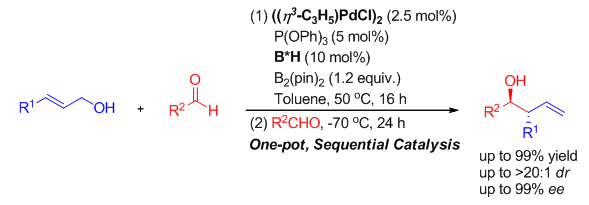| [1] (a) Chemler, S. R.; Roush, W. R. In Modern Carbonyl Chemistry, Ed.: Otera, J., Wiley-VCH, Weinheim, Germany, 2000, pp. 403~490;
(b) Elford, T. G.; Hall, D. G. Synthesis 2010, 893;
(c) Yus, M.; González-Gómez, J. C.; Foubelo, F. Chem. Rev. 2013, 113, 5595.
[2]
(a) Yamamoto, Y.; Asao, N. Chem. Rev. 1993, 93, 2207;
(b) Denmark, S. E.; Fu, J. Chem. Rev. 2003, 103, 2763;
(c) Yus, M.; González-Gómez, J. C.; Foubelo, F. Chem. Rev. 2011, 111, 7774.
[3] For examples with chiral Lewis acids as catalysts, see:
(a) Furuta, K.; Mouri, M.; Yamamoto, H. Synlett 1991, 561;
(b) Costa, A. L.; Piazza, M. G.; Tagliavini, E.; Trombini, C.; Umani-Ronchi, A. J. Am. Chem. Soc. 1993, 115, 7001;
(c) Keck, G. E.; Tarbet, K. H.; Geraci, L. S. J. Am. Chem. Soc. 1993, 115, 8467;
(d) Ishiyama, T.; Ahiko, T.-A.; Miyaura, N. J. Am. Chem. Soc. 2002, 124, 12414;
(e) Wada, R.; Oisaki, K.; Kanai, M.; Shibasaki, M. J. Am. Chem. Soc. 2004, 126, 8910.
[4] For examples with chiral Lewis bases as catalysts, see:
(a) Denmark, S. E.; Fu, J. J. Am. Chem. Soc. 2001, 123, 9488;
(b) Malkov, A.; Orsini, M.; Pernazza, D.; Muir, K. W.; Langer, V.; Meghani, P.; Kocovsky, P. Org. Lett. 2002, 4, 1047;
(c) Denmark, S. E.; Fu, J. J. Am. Chem. Soc. 2003, 125, 2208;
(d) Malkov, A. V.; Bell, M.; Castelluzzo, F.; Kocovsky, P. Org. Lett. 2005, 7, 3219;
(e) Denmark, S. E.; Fu, J.; Coe, D. M.; Su, X.; Pratt, N. E.; Griedel, B. D. J. Org. Chem. 2006, 71, 1513;
(f) Malkov, A. V.; Ramirez-Lopez, P.; Biedermannova, L.; Rulisek, L.; Dufkova, L.; Kotora, M.; Zhu, F.; Kocovsky, P. J. Am. Chem. Soc. 2008, 130, 5341;
(g) Bai, B.; Yang, J.; Zhang, G.-H.; Mao, D.-B. Chin. J. Org. Chem. 2015, 35, 975(in Chinese). (白冰, 杨静, 张改红, 毛多斌, 有机化学, 2015, 35, 975.)
[5] For examples with chiral Brønsted acids as catalysts, see:
(a) Rauniyar, V.; Hall, D. G. Angew. Chem., Int. Ed. 2006, 45, 2426;
(b) Rauniyar, V.; Zhai, H.; Hall, D. G. J. Am. Chem. Soc. 2008, 130, 8481;
(c) Rauniyar, V.; Hall, D. G. J. Org. Chem. 2009, 74, 4236;
(d) Jain, P.; Antilla, J. C. J. Am. Chem. Soc. 2010, 132, 11884;
(e) Xing, C.-H.; Liao, Y.-X.; Zhang, Y.; Sabarova, D.; Bassous, M.; Hu, Q.-S. Eur. J. Org. Chem. 2012, 1115.
[6] For other examples of asymmetric carbonyl allylation reactions, see:
(a) Kim, I. S.; Ngai, M.; Krische, M. J. J. Am. Chem. Soc. 2008, 130, 14891;
(b) Lou, S.; Moquist, P. N.; Schaus, S. E. J. Am. Chem. Soc. 2006, 128, 12660;
(c) Barnett, D. S.; Moquist, P. N.; Schaus, S. E. Angew. Chem., Int. Ed. 2009, 48, 8679.
[7] For the selected achiral examples, see:
(a) Sebelius, S.; Wallner, O. A.; Szabó, K. J. Org. Lett. 2003, 5, 3065;
(b) Selander, N.; Sebelius, S.; Estay, C.; Szabó, K. J. Eur. J. Org. Chem. 2006, 4085;
(c) Se- lander, N.; Kipke, A.; Sebelius, S.; Szabó, K. J. J. Am. Chem. Soc. 2007, 129, 13723;
(d) Olsson, V. J.; Szabó, K. J. Angew. Chem., Int. Ed. 2007, 46, 6891;
(e) Selander, N.; Szabó, K. J. Chem. Commun. 2008, 3420;
(f) Zhou, Y.-H.; Wang, H.; Liu, Y.; Zhao, Y.-L.; Zhang, C.-X.; Qu, J.-P. Org. Chem. Front. 2017, 4, 1580.
[8] For the examples of using chiral diboronates, see:
(a) Sebelius, S.; Szabó, K. J. Eur. J. Org. Chem. 2005, 2539;
(b) Vogt, M.; Ceylan, S.; Kirschning, A. Tetrahedron 2010, 66, 6450.
[9]
(a) Zanoni, G.; Gladiali, S.; Marchetti, A.; Piccinini, P.; Tredici, I.; Vidari, G. Angew. Chem., Int. Ed. 2004, 43, 846;
(b) Zhu, S.-F.; Yang, Y.; Wang, L.-X.; Liu, B.; Zhou, Q.-L. Org. Lett. 2005, 7, 2333;
(c) Howell, G. P.; Minnaard, A. J.; Feringa, B. L. Org. Biomol. Chem. 2006, 4, 1278;
(d) Yu, Y.-N.; Xu, M.-H. Acta Chim. Sinica 2017, 75, 655(in Chinese). (于月娜, 徐明华, 化学学报, 2017, 75, 655.)
[10]
(a) Zhu, S.-F.; Qiao, X.-C.; Zhang, Y.-Z.; Wang, L.-X.; Zhou, Q.-L. Chem. Sci. 2011, 2, 1135;
(b) Tsukamoto, H.; Kawase, A.; Doi, T. Chem. Commun. 2015, 51, 8027.
[11] Yatagai, M.; Yamagishi, T.; Hida, M. Bull. Chem. Soc. Jpn. 1984, 57, 823.
(b) McIntosh, J. M.; Leavitt, R. K. Tetrahedron Lett. 1986, 27, 3839.
(c) Jiang, Y. Z.; Liu, G.; Zhou, C. Y.; Piao, H. R.; Wu, L. J.; Mi, A. Q. Synth. Commun. 1991, 21, 1087.
[12]
(a) Li, L.-L.; Tao, Z.-L.; Han, Z.-Y.; Gong, L.-Z. Org. Lett. 2017, 19, 102;
(b) Tang, H.-M.; Huo, X.-H.; Meng, Q.-H.; Zhang, W.-B. Acta Chim. Sinica 2016, 74, 219(in Chinese). (汤淏溟, 霍小红, 孟庆华, 张万斌, 化学学报, 2016, 74, 219.)
[13]
(a) Grayson, M. N.; Pellegrinet, S. C.; Goodman, J. M. J. Am. Chem. Soc. 2012, 134, 2716.
(b) Wang, H.; Jain, P.; Antilla, J. C.; Houk, K. N. J. Org. Chem. 2013, 78, 1208.
(c) Incerti-Pradillos, C. A.; Kabeshov, M. A.; Malkov, A. V. Angew. Chem., Int. Ed. 2013, 52, 5338.
[14]
(a) Chen, G.; Deng, Y.; Gong, L.; Mi, A.; Cui, X.; Jiang, Y.; Choi, M. C. K.; Chan, A. S. C. Tetrahedron: Asymmetry 2001, 12, 1567.
(b) Nakoji, M.; Kanayama, T.; Okino, T.; Takemoto, Y. Org. Lett. 2001, 3, 3329.
(c) Park, Y. J.; Park, J.-W.; Jun, C.-H. Acc. Chem. Res. 2008, 41, 222.
(d) Shao, Z.; Zhang, H. Chem. Soc. Rev. 2009, 38, 2745.
(e) Du, Z.; Shao, Z. Chem. Soc. Rev. 2013, 42, 1337.
(f) Wu, X.; Li, M.-L.; Gong, L.-Z. Acta Chim. Sinica 2013, 71, 1091(in Chinese). (吴祥, 李明丽, 龚流柱, 化学学报, 2013, 71, 1091.)
(g) Chen, D.-F.; Han, Z.-Y.; Zhou, X.-L.; Gong, L.-Z. Acc. Chem. Res. 2014, 47, 2365.
(h) Yang, Z.-P.; Zhang, W.; You, S.-L. J. Org. Chem. 2014, 79, 7785.
[15] Jiang, G.-X.; List, B. Angew. Chem., Int. Ed. 2011, 50, 9471.
[16] Tao, Z.-L.; Zhang, W.-Q.; Chen, D.-F.; Arafate Adele; Gong, L.-Z. J. Am. Chem. Soc. 2013, 135, 9255. |
